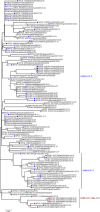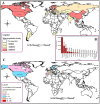Transmission dynamics and susceptibility patterns of SARS-CoV-2 in domestic, farmed and wild animals: Sustainable One Health surveillance for conservation and public health to prevent future epidemics and pandemics
- PMID: 34694705
- PMCID: PMC8662162
- DOI: 10.1111/tbed.14356
Transmission dynamics and susceptibility patterns of SARS-CoV-2 in domestic, farmed and wild animals: Sustainable One Health surveillance for conservation and public health to prevent future epidemics and pandemics
Abstract
The exact origin of Severe Acute Respiratory Syndrome Coronavirus 2 (SARS-CoV-2) and source of introduction into humans has not been established yet, though it might be originated from animals. Therefore, we conducted a study to understand the putative reservoirs, transmission dynamics, and susceptibility patterns of SARS-CoV-2 in animals. Rhinolophus bats are presumed to be natural progenitors of SARS-CoV-2-related viruses. Initially, pangolin was thought to be the source of spillover to humans, but they might be infected by human or other animal species. So, the virus spillover pathways to humans remain unknown. Human-to-animal transmission has been testified in pet, farmed, zoo and free-ranging wild animals. Infected animals can transmit the virus to other animals in natural settings like mink-to-mink and mink-to-cat transmission. Animal-to-human transmission is not a persistent pathway, while mink-to-human transmission continues to be illuminated. Multiple companions and captive wild animals were infected by an emerging alpha variant of concern (B.1.1.7 lineage) whereas Asiatic lions were infected by delta variant, (B.1.617.2). To date, multiple animal species - cat, ferrets, non-human primates, hamsters and bats - showed high susceptibility to SARS-CoV-2 in the experimental condition, while swine, poultry, cattle showed no susceptibility. The founding of SARS-CoV-2 in wild animal reservoirs can confront the control of the virus in humans and might carry a risk to the welfare and conservation of wildlife as well. We suggest vaccinating pets and captive animals to stop spillovers and spillback events. We recommend sustainable One Health surveillance at the animal-human-environmental interface to detect and prevent future epidemics and pandemics by Disease X.
Keywords: COVID-19; Rhinolophus bats; alpha variant; delta variant; horseshoe bat; mink; pangolin.
© 2021 Wiley-VCH GmbH.
Conflict of interest statement
The authors declare that they have no conflict of interest.
Figures





Similar articles
-
SARS-CoV-2 in animals: potential for unknown reservoir hosts and public health implications.Vet Q. 2021 Dec;41(1):181-201. doi: 10.1080/01652176.2021.1921311. Vet Q. 2021. PMID: 33892621 Free PMC article. Review.
-
Animals and SARS-CoV-2: Species susceptibility and viral transmission in experimental and natural conditions, and the potential implications for community transmission.Transbound Emerg Dis. 2021 Jul;68(4):1850-1867. doi: 10.1111/tbed.13885. Epub 2020 Nov 4. Transbound Emerg Dis. 2021. PMID: 33091230 Free PMC article. Review.
-
Spatial epidemiology and genetic diversity of SARS-CoV-2 and related coronaviruses in domestic and wild animals.PLoS One. 2021 Dec 15;16(12):e0260635. doi: 10.1371/journal.pone.0260635. eCollection 2021. PLoS One. 2021. PMID: 34910734 Free PMC article.
-
Understanding the prevalence of SARS-CoV-2 (COVID-19) exposure in companion, captive, wild, and farmed animals.Virulence. 2021 Dec;12(1):2777-2786. doi: 10.1080/21505594.2021.1996519. Virulence. 2021. PMID: 34696707 Free PMC article. Review.
-
SARS CoV-2 infections in animals, two years into the pandemic.Arch Virol. 2022 Dec;167(12):2503-2517. doi: 10.1007/s00705-022-05609-1. Epub 2022 Oct 7. Arch Virol. 2022. PMID: 36207554 Free PMC article. Review.
Cited by
-
Resurgence of SARS-CoV-2 Delta after Omicron variant superinfection in an immunocompromised pediatric patient.Virol J. 2023 Oct 27;20(1):246. doi: 10.1186/s12985-023-02186-w. Virol J. 2023. PMID: 37891657 Free PMC article.
-
Molecular surveillance of potential SARS-CoV-2 reservoir hosts in wildlife rehabilitation centers.Vet Q. 2023 Dec;43(1):1-10. doi: 10.1080/01652176.2023.2164909. Vet Q. 2023. PMID: 36594266 Free PMC article.
-
Surveillance strategies for SARS-CoV-2 infections through one health approach.Heliyon. 2024 Aug 30;10(17):e37128. doi: 10.1016/j.heliyon.2024.e37128. eCollection 2024 Sep 15. Heliyon. 2024. PMID: 39286214 Free PMC article. Review.
-
SARS-CoV-2 and natural infection in animals.J Med Virol. 2023 Jan;95(1):e28147. doi: 10.1002/jmv.28147. Epub 2022 Sep 28. J Med Virol. 2023. PMID: 36121159 Free PMC article. Review.
-
Transmission Dynamics and Genomic Epidemiology of Emerging Variants of SARS-CoV-2 in Bangladesh.Trop Med Infect Dis. 2022 Aug 20;7(8):197. doi: 10.3390/tropicalmed7080197. Trop Med Infect Dis. 2022. PMID: 36006289 Free PMC article.
References
-
- Anon . (2012). People, pathogens and our planet: The economics of one health Retrieved from https://openknowledge.worldbank.org/handle/10986/11892 [Accessed June 3, 2021]. World Bank.
-
- Anon . (2018). Fur farming bans. Retrieved from https://www.furfreealliance.com/fur‐bans/ [Accessed June 3, 2021].
-
- Anthony, S. J. , Epstein, J. H. , Murray, K. A. , Navarrete‐Macias, I. , Zambrana‐Torrelio, C. M. , Solovyov, A. , Ojeda‐Flores, R. , Arrigo, N. C. , Islam, A. , & Ali Khan, S. (2013). A strategy to estimate unknown viral diversity in mammals. MBio, 4(5), e00598‐00513. 10.1128/mBio.00598-13 - DOI - PMC - PubMed
-
- Bao, L. , Deng, W. , Gao, H. , Xiao, C. , Liu, J. , Xue, J. , Lv, Q. , Liu, J. , Yu, P. , & Xu, Y. (2020a). Reinfection could not occur in SARS‐CoV‐2 infected rhesus macaques. bioRxiv, 1–21. 10.1101/2020.03.13.990226 - DOI
Publication types
MeSH terms
Supplementary concepts
Grants and funding
LinkOut - more resources
Full Text Sources
Medical
Miscellaneous

